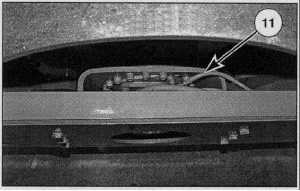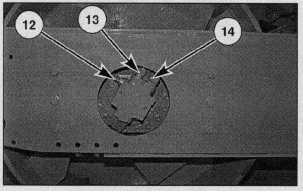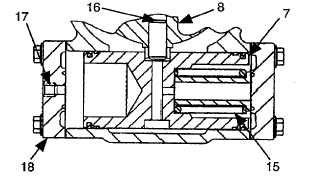TM 5-3895-382-24
Drum Propel.
(11) Brake line. (12) Case drain outlet. (13) Closed circuit loop line.
(14) Closed circuit loop line.
High pressure oil enters the motor through closed circuit loop
line (13). Oil flows through port plate (1) to piston (2) in
cylinder block (5). The force of the oil pushes the piston
against swashplate (8). The piston reacts by trying to reach
maximum outward stroke. Since the swashplate is at an angle,
the piston starts to move along the swashplate. This
movement causes the cylinder and output shaft (4) to rotate.
As the cylinder and output shaft continue to rotate, the piston
moves around the angled swashplate and piston stroke starts
to decrease. Oil is forced through the opposite side of port
plate (1) to low pressure closed circuit loop line (14).
NOTE:
Closed circuit loop line (14) is called a low
pressure loop line, and dosed circuit loop line (13)
is called a high pressure loop line in this example.
Moving the pump swashplate overcenter in the
opposite direction causes a change in the
direction of flow in the pump and motor closed
circuit loop (FORWARD or REVERSE operation).
Closed circuit loop line (14) becomes high
pressure and closed circuit loop line (13)
becomes low pressure. A change in the direction
of flow in the closed loop circuit causes a change
in motor direction of rotation.
Charge pressure on the low pressure side of the closed circuit
loop is routed through the motor flush valve to the motor case.
Oil from the motor flush valve enters the motor case through
case drain outlet (12). Oil circulated through the motor case
serves to cool and flush the motor.
Drum Motor Servo Control.
(7) Servo piston assembly. (8) Swashplate. (15) Spring. (16) Pin.
(17) Servo pressure port. (18) End cap.
The motor uses servo piston assembly (7) to change the
operating angle of swashplate (8). The assembly is controlled
by the pump charge pressure through the speed shift control
valve. The speed shift switch is located on the main console.
The piston is connected to the swashplate by pin (16). Servo
pressure port (17) is located in end cap (18). When the speed
shift switch is in the HIGH position, the control valve opens.
Change oil pressure at the servo pressure port acts on the
piston and overcomes the force of spring (15). The piston
moves and causes the swashplate to rotate. In this position
the swashplate is at the minimum angle. At minimum angle,
the motor pistons have minimum stroke (displacement) and
can produce high speeds.
When the switch is in the LOW position, the control valve
closes and oil pressure to the servo pressure port is open to
tank. Spring (15) pushes piston servo assembly (7) and
causes swashplate (8) to rotate. The spring holds the piston
and swashplate at the maximum angle. At maximum angle,
the motor pistons have maximum stroke (displacement) and
can produce low speeds.
11-12





